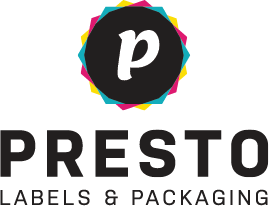Uploading Artwork
Before uploading artwork, you must first create an account and log in. You will then be able to upload your artwork before paying for your order.
We accept files in the following formats: pdf, ai, psd, eps, tiff, png, jpg, and indd. It is best to send your files in the native format created by the software and saved as a pdf. Please upload all images and fonts used in your artwork if they are not embedded in your art file.
How To Prepare Your Artwork for Print
We have created informational videos that will help you prepare your label’s artwork for print. If you still have questions about preparing your files for printing, or if you need full graphic design services, please call us at 1-800- 201- 7120.
To view the videos, please click on the thumbnail below.
Document Size
Create a new document 0.125″ larger, in both directions, than the label size.
If you want a label that is 4″ wide by 2.5″ high, the document size should be 4.125″ x 2.625″. Next, create a box or shape with a stroke, which is the exact size of the label. Color the stroke so that it stands out as the die line. Place your art in position in the document.
Bleed
Whenever the art touches the edge of the label, a bleed is needed.
Extend printed objects 0.0625″ past the internal and external cut lines. This bleeds the color beyond the die line, allowing for the best quality when cutting out the label.
Color
Digital printing uses 4-color process inks (cyan, magenta, yellow and black) to create full color graphics.
Digital printing can only create close matches to PMS and spot colors. No fluorescent or metallic inks are possible. We can simulate metallic by printing color and opaque white on a silver material.
Although we cannot guarantee custom color matches for all colors, we can closely match a wide range of hues. You will need to provide either a solid coated Pantone® color or a printed sample of a color for us to match. Please specify color matching when placing your order and call it out when signing off on your proofs. If color matching is not specified, your files will be printed as they were built. Color matching can delay the printing process depending on how art files are constructed.
Images
Vector images are made up of scalable objects, whereas raster images are made up of pixels. A vector image is generated by an algorithm that permits the image to scale up or down with no loss of image quality. This is the preferred format for text and line art (Adobe Illustrator®).
A rasterized image is a pixel-based image in which the resolution is predetermined at the beginning of the build process. Photographic images are usually raster-based. Once the resolution is established for a raster image, adjustments to a higher resolution will degrade the image quality (Adobe Photoshop®).
Fonts
Outline or send all fonts used in the file.
There are often multiple versions of common font names, and they are not exactly alike. To prevent spacing and layout issues, we request that fonts be outlined or sent with the art file.
Barcodes
Barcodes have very specific purposes and use.
We will make every attempt to evaluate the scannability of your 2D and 3D barcode based on industry standards. If we determine that there may be an issue with the function of your code in production, we will notify you of issues along with possible solutions. You will need to submit corrected art before we move forward into production. In many cases, our art department can fix these problems (art charges may apply). Changes will require your approval before proceeding with production. If you choose to have no changes made, you will be required to acknowledge that you have been informed of possible issues before proceeding with production.
